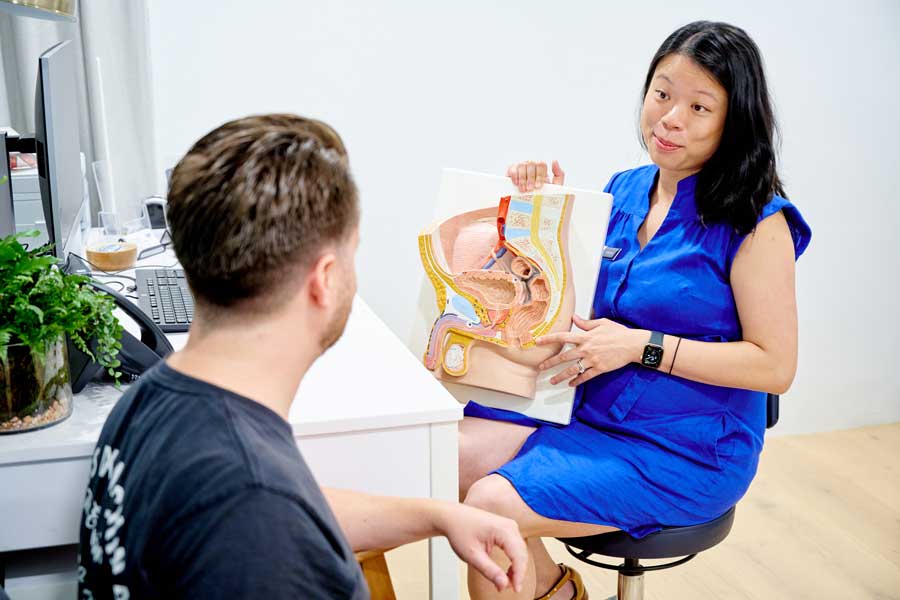Learn how Physiotherapy education and treatment can help reduce the recurrence and stress of mastitis and blocked ducts.
For many new mothers, the journey of breastfeeding is a profoundly rewarding experience, fostering a unique bond with their newborns while providing essential nutrition. However, this journey is a steep learning curve for many – women regularly encounter roadblocks, one of the most common being blocked milk ducts. This issue, though painful and frustrating, is surprisingly common and can often be effectively managed with the assistance of Physiotherapy if caught early.
Understanding your Breasts
Your breast is delicate glandular tissue with about 9 milk ducts running through it towards the nipple. In early pregnancy your ducts begin lengthening and profusely branch to develop a larger and more complex ductal tree. Each woman’s breast tissue and nipple anatomy is completely unique. Nipples can differ in shape, flexibility and direction. Duct diameter size can vary from 0.5mm to 6.5mm at rest, to 0.7mm to 7.5mm during a milk ‘let down’.
How Milk is Produced
In the second half of pregnancy your body starts to make colostrum. In some cases women can express colostrum by 36 weeks, however the ability to express colostrum does not indicate what your milk production will be like. Over the first 30-40 hours after delivery of your baby and placenta, your body works on changing the colostrum into milk. The most important component in ‘drawing the milk down’ is nipple stimulation. This is done by offering your baby regular feeds, multiple times a day (and if you have a sleepier baby adding regular hand expression).
With the regular nipple stimulation your milk production will increase 10 x by days 3-5. The removal of milk sends feedback to your body to continue to produce milk; the female body will indefinitely produce milk if the milk is removed. Over the next few weeks as your breasts learn your baby’s patterns (how much and how often they like to drink) your supply will start to regulate to the specific needs of your baby. Using breast pumps can complicate your milk production journey as it can create more milk than your baby requires. Commencing and ceasing pumping should be a slow, gradual process. It is helpful to work with health professionals trained in this area to support you.
Blocked milk ducts occur when there is an oversupply in the milk, so it is not removed from the breast tissue. This can result from factors such as: use of breast pumps, poor latch, nipple damage, a sudden change in your baby’s feeding pattern or skipping a feed, tight or restricted clothing, sleeping on your stomach or even stress.

Mastitis and Blocked Milk Ducts
Mastitis is an inflammation or infection of the breast tissue that causes breast pain, swelling, warmth and redness in one or both breasts. While it can affect anyone, it is much more prevalent in breastfeeding women and usually occurs in the first few weeks of breastfeeding. Common causes include oversupply of milk, blocked milk ducts, infection, and injury to the breast tissue.
Blocked ducts is a condition that refers to a blockage of the ducts that carry milk to the nipple for breastfeeding. Early intervention – such as home strategies, advice for feeding, and exercise to promote lymph drainage, and therapeutic ultrasound with a women’s health physio – is key with this condition because it prevents engorgement and infective mastitis by clearing the blockage.
Symptoms of Blocked Ducts
The most common symptoms are:
- Tenderness
- Swollen
- Pink or red area
- Discomfort/pain when feeding or to touch
- Firm lump
Symptoms of Mastitis
The symptoms of mastitis can include the above symptoms of a blocked duct, and may also include:
- Fever
- Fatigue/aching
- Feeling generally unwell

The Role of Our Physiotherapists
Our team offers a holistic approach to managing and preventing blocked ducts, focusing on manual techniques, advice for pain relief and overall support.
1. Therapeutic Ultrasound and Heat Therapy:
- Therapeutic Ultrasound: This technique involves using sound waves to generate heat deep within the breast tissue. The heat helps to increase blood flow, reduce inflammation, and promote healing.
- Heat Therapy: Applying heat directly to the affected area can also help to loosen the blockage, encourage blood flow and alleviate pain.
2. Manual Techniques
- Breast Yoga: our trained Physiotherapists provide gentle massage, rotation of the breast tissue, contract/relax exercises and diaphragmatic breathing. This technique aids in clearing the blocked duct by encouraging the movement of accumulated fluids.
3. Education & Support
- Understanding Breast Anatomy and Function: our team can provide valuable insights into breast anatomy and how it relates to breastfeeding. This knowledge empowers mothers to recognise early signs of blockages and take proactive steps to address them.
- Breastfeeding Positioning & Taping Techniques: Physiotherapists can educate mothers on breastfeeding positions that reduce physical tension in the body and use taping techniques to lift the breast tissue. These can help achieve a more effective milk flow and reduce the likelihood of developing new blockages.
- Stress Management: The journey of motherhood can be stressful, addressing stress through relaxation techniques may also be part of your sessions. Stress is known to contribute to decreased milk flow and increased susceptibility to blocked ducts.

The Path to Relief
While blocked ducts may momentarily disrupt the joy of breastfeeding, the collaboration with trained Physiotherapists offers a pathway to relief. Our Physio team at Sydney Pelvic Clinic aim to provide relief of blocked ducts and help you foster a positive breastfeeding experience.
Our “Bump, Birth & Beyond” program has been designed to support you through your pregnancy and postnatal journey. By integrating Physiotherapy into your postnatal care plan, we believe you can benefit from personalised support that enhances comfort, confidence, and overall well-being. Call us to book in with an experienced Physiotherapist.

